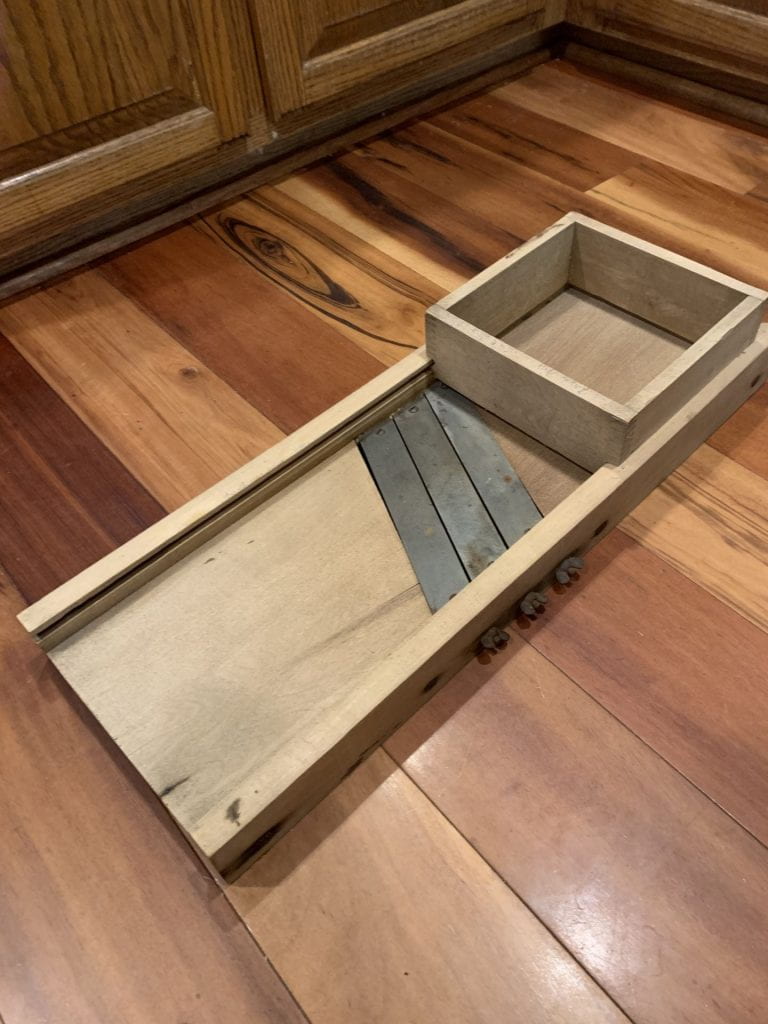Sauerkraut
Submitted by: Chris Goering with Tim Goering

Growing up there were always freezer bags full of sauerkraut in the family freezers. Each year towards the end of summer (late September) my grandfather would drag out several large pickling crocks, sharpen the blades of the kraut cutters, order 200-250 pounds of Colorado cabbage from the grocery store, and invite the family over to their garage in McPherson, Kansas. Cutting 250 pounds of cabbage is not for the weak armed or faint of heart and more than once someone let a knuckle get a little close to the business end of the kraut cutter. As time marched on, he found these relics–both cutters and crocks–at various garage sales, estate sales, auctions, etc., and would bring them home for repair prior to the big day.
The specifics of the recipe aren’t as precise as one might prefer who invests this kind of time and energy and cabbage..into the endeavor. And there’s nothing for the faint of heart or stomach about the smell of the garage while that much cabbage ferments. Following much advice online I’ve replaced the stone crocks (which featured quite a bit of lead in their construction that leaches into the sauerkraut) with food grade five gallon plastic buckets. The first time I tried this after my grandfather passed away, I rescued a kraut cutter (mandolin style) from an antique store, treated the wood with mineral oil, sharpened the blades, and pressed it back into service.
Look, take it from me, double bag the kraut and make sure it is sealed prior to freezing. We had an entire deep freeze worth of food that took on a sauerkraut flavor to it when a bag leaked. While I personally love sauerkraut and there’s nothing better than homemade, nothing else in a deep freeze tastes good—at all—flavored with the essence of fermentation. The first time I attempted this with 60 pounds of cabbage and then bumped up to 160. Perhaps the right amount was somewhere in the middle. Many hands make light work and it’s a good idea to have help so that others can share in the tasty harvest of the year’s sauerkraut.
We eat ours mixed with ham most frequently, but I also love it with German sausage cut up in it. I’ve included advice on the recipe for preparing sauerkraut that my grandmother used below. Sure, I like it better with gravy or ham or sausage in it but also like it just fine on its own. See below for a vegan twist.
Making Sauerkraut
Peel off outside leaves and core cabbage heads. Finely shredded cabbage into crock/bucket occasionally stirring in pickling salt at an overall ratio of 2 cups to 50 lbs. Occasionally stir vigorously and pack down until foaming and juicing appear at the top. Repeat as often as necessary. Cover completely with outside leaves of the cabbage heads and tuck them in around the edges about 1/4 of an inch deep. Cover this with cheese cloth also tucking around the edges. Keep enough space in your crock for a weighted object to sit on top of a plate on top of the cheese cloth to hold cabbage down in the brine. External temperature plays a role in when the kraut will be ready. Usually anywhere from 10 days to 2.5 weeks. The juice will be sucked back down to the bottom of the crock/bucket when your cabbage has become sauerkraut. At this point you may can or freeze your bounty.
Preparing Sauerkraut
Ingredients: kraut, onion, bacon, and flour
Process: Pour excess juice off kraut and cook over med. heat in the kettle stirring occasionally. Sear bacon until crispy (quantity is personal preference from here on out). Add chopped onion to bacon and the drippings and stir frequently until translucent. Add a teaspoon or two of flour and continue stirring. You should have an opaque to milky white rendering. This is the schmalz. The kraut should be done in 15 to 18 minutes. Pour off the juice once again, then stir in your schmalz. Of course you can deviate with other ingredients. A vegan version using grape seed oil and sautéed caraway seed, juniper berries, and pine nuts was fantastic!